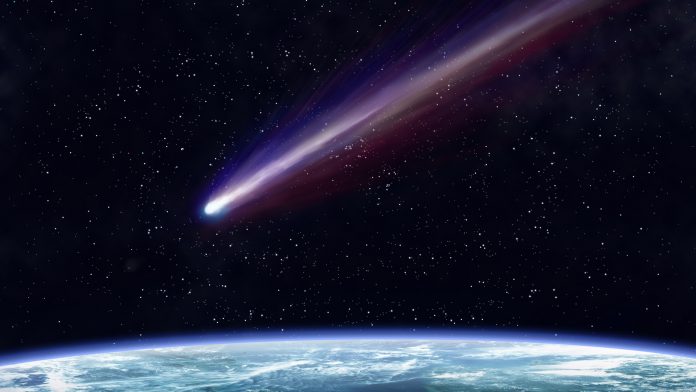Researchers at Kobe University have conducted research that will allow for an increased number of astronomical bodies to be considered as candidates for the source of the water and organic substances necessary for the beginning of life on Earth.
Current theories suggest that the water and organic substances required for the beginning of life on Earth were due to astronomical bodies such as a comet or an asteroid impacting the planet.
Minerals and organic substances that have experienced aqueous alteration have been detected in meteorites – from which asteroids originate – offering substantial evidence that they once contained water. However, a heat source is essential for the chemical reactions that lead to aqueous alteration and organic solid formation inside asteroids.
In recent years, the hypothesis that the impact heat generated when a small astronomical body hits an asteroid could also be a viable heat source has become more prominent. However, it is not understood how much heat is generated depending on the astronomical body’s characteristics (size, density, impact speed) and how far within the asteroid this produced heat is transmitted.
Up until now, there has been no research experimentally studying this heat generation and propagation process to ascertain whether aqueous alteration and organic substance formation would be possible.
Now, a team of researchers from Kobe University has revealed that the heat produced by the impact of a small astronomical body may facilitate aqueous alteration – whereby minerals inside a rock transform due to a chemical reaction between the rock and water – with organic solid formation taking place on the surface of an asteroid.
They accomplished this by conducting high-velocity impact cratering experiments by applying an asteroid-like target material and assessing the post-impact heat distribution around the subsequent crater. From these results, they were able to determine a rule-of-thumb for maximum temperature and the duration of the heating and built a heat conduction model from this.
The researchers’ findings have been published in the journal Communications Earth and Environment.
The team was comprised of members from Kobe University’s Graduate School of Science, including Lecturer Yasui Minami, Tazawa Taku, Hashimoto Ryohei, and Professor Arakawa Masahiko, in addition to JAXA Space Exploration Center’s Associate Senior Researcher Ggawa Kazunori.
They employed porous gypsum as an artificial asteroid and implanted various thermocouples – a heat sensor consisting of two rods – inside it. They performed high-velocity impact tests on this target at impact speeds of 1km/s and over, and successfully recorded shifts in temperature duration around the subsequent crater soon after impact.
This experiment uncovered that, despite the impact speed and projectile’s size and density, the highest temperature and its duration were reliant upon dimensionless distance (the distance from the impact point scaled by the crater radius).
With these findings, the group were able to determine the temporal changes in thermal heat distribution after the crater’s formation on the asteroid’s surface. These outcomes indicated that, at distances within two astronomical units, aqueous alteration can take place if the crater has a radius of over 20km, and organic solid formation can be supported by craters of over one kilometre.
These team’s findings have increased the spatial and temporal range over which the essential conditions for aqueous alteration and organic solid formation could take place. This is expected to substantially improve the number of prospective astronomical bodies that may have brought water and the origins of life to Earth.









